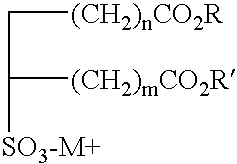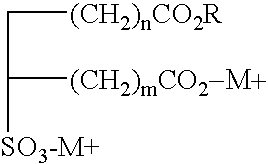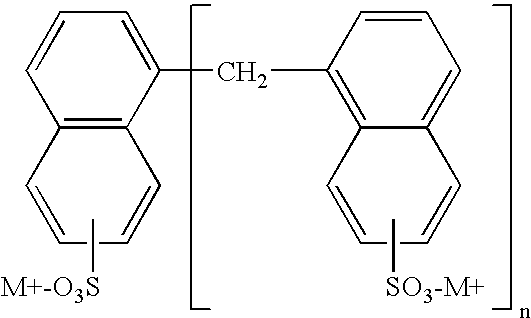Compositions of suspended non-aggregated carbon nanotubes, methods of making the same, and uses thereof
a carbon nanotube, non-aggregation technology, applied in the direction of non-metal conductors, other chemical processes, conductors, etc., can solve the problems of inability to meet the form of the material, the tangled form of the bulk material cannot be used in many of the projected applications, and the current available macroscopic forms of swnts are isotropic and rather fragil
- Summary
- Abstract
- Description
- Claims
- Application Information
AI Technical Summary
Benefits of technology
Problems solved by technology
Method used
Image
Examples
example 5.1
Suspension of Carbon Nanotubes
[0087]A given amount of purified carbon nanotubes in distilled water, which appeared as black undispersed clumps, was dried in a vacuum oven. The surfactant used was cetyltrimethylammonium bromide (CTAB). In aqueous solutions the critical micelle concentration (CMC) for CTAB is 0.9mM. For temperatures above the Krafft point and concentrations less than the CMC the surfactant exists on the average as unassociated molecules in the solution (J. L. Moilliet and B. Collie, Surface Activity (D. Van Nostrand Co., N Y 1951), see also G. J. T. Tiddy, Physics Reports 57, 2(1980)). Below the Krafft point (about 22 celsius for CTAB) most of the surfactant crystallized out of the suspension and settled to the bottom of the container. Above the Krafft point and above the CMC, the CTAB first formed spherical micelles which then evolved to rod-like micelles with increasing concentration of CTAB.
[0088]The dried nanotube clumps were added to stock solutions of CTAB / water...
example 5.2
Stability of Suspended Carbon Nanotubes
[0089]Under long term storage of the suspended carbon nanotubes of Example 5.1 for a period of a few weeks some of the suspended nanotubes settled out. This was possibly due to the samples being stored at a temperature slightly below the Krafft point of CTAB. (The average temperature in the lab was 19-22° C.) The settled material had the appearance of black clumps of a spongy consistency. Another possible mechanism of coagulation is depletion flocculation (see, e.g., A. G.Yodh, et al, Phil. Trans. R. Soc. Lond. A 359, 921-937 (2001)). The remaining solution remained opaque. The values quoted in Example 5.1 (5-6gm / L) pertain to these aged samples.
[0090]Clear residual surfactant adsorbed onto the nanotube's surfaces stabilizes the remaining suspension. Studies of surfactants adsorbed to graphite surfaces show cationic surfactants are adsorbed as parallel straight stripes of half cylindrical micellar aggregates (S. Manne et al., Science 270, 1480 ...
example 5.3
Preparation of Suspended Carbon Nanotubes
[0091]Single-walled carbon nanotubes, purified by standard methods, were weighed in the amount of 0.1453g. Boiled deionized water (DI water) measured in the amount of 10.005g was mixed with the SWNTS. An amount of 0.1994 g of CTAB was added to this mixture. The mixture was sonicated in a sonicating bath for 2 minutes, then allowed to rest overnight at 25 ° C. The mixture was then sonicated for an hour. The concentration was measured by taking a known aliquot of the suspension and drying it in a pre-weighed petri in a vacuum oven. After drying is complete the mass of the perti dish plus the aliquot of suspension is measured. The concentration of CTAB is known and the mass of the petri is known, so from this one may calculate the mass of the SWNTs left after drying. For the experiment described above the concentration of SWNTs in water with surfactant was measured at 12 g / L.
[0092]It is preferable that the concentration of surfactant be at least...
PUM
| Property | Measurement | Unit |
|---|---|---|
| temperature | aaaaa | aaaaa |
| temperature | aaaaa | aaaaa |
| temperature | aaaaa | aaaaa |
Abstract
Description
Claims
Application Information
 Login to View More
Login to View More - R&D
- Intellectual Property
- Life Sciences
- Materials
- Tech Scout
- Unparalleled Data Quality
- Higher Quality Content
- 60% Fewer Hallucinations
Browse by: Latest US Patents, China's latest patents, Technical Efficacy Thesaurus, Application Domain, Technology Topic, Popular Technical Reports.
© 2025 PatSnap. All rights reserved.Legal|Privacy policy|Modern Slavery Act Transparency Statement|Sitemap|About US| Contact US: help@patsnap.com



